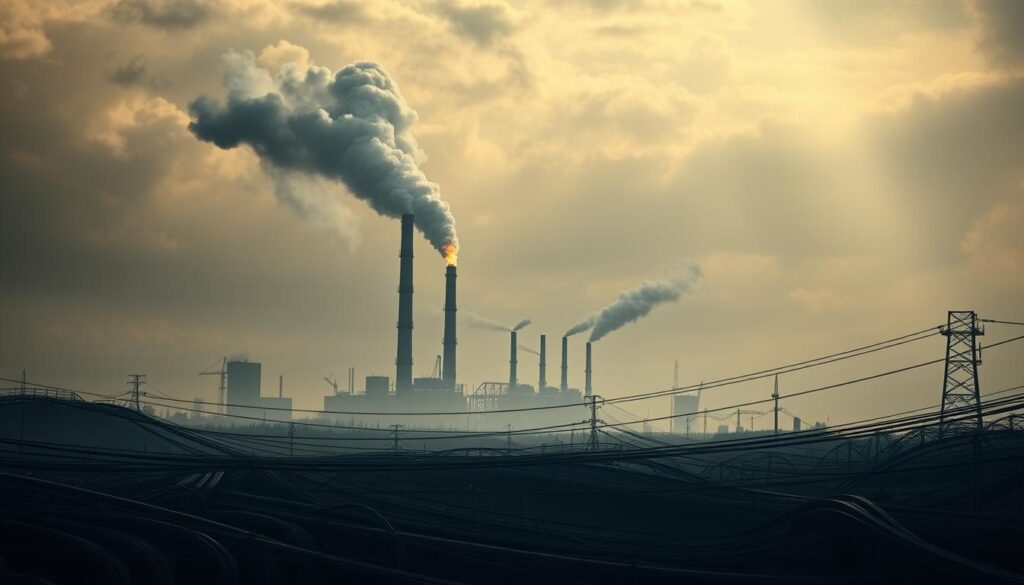
#image_title
In recent years, many companies have proudly claimed to be “carbon neutral” or environmentally responsible. But how much of this is genuine effort, and how much is just a green façade? Our investigation dives into the unsettling truth behind the misuse of carbon credits by major industries. We uncover how corporations often rely on cheap and ineffective offsets, diverting attention from real emission reduction efforts1.
For example, studies reveal that 33% of the offsets portfolio for top corporate buyers is classified as “likely junk”1. Similarly, 43% of the credits purchased by oil and gas majors are for flawed projects, raising serious concerns about their effectiveness1. These practices not only fail to address the climate crisis but may even worsen global heating.
Our analysis highlights the urgent need for systemic reforms in the carbon market. We’ll explore real-world examples from industry giants like Disney, Shell, and Gucci, backed by verifiable data from respected media and academic studies2. It’s time to challenge the status quo and demand accountability for genuine climate action.
Key Takeaways
- Many corporate “carbon neutral” claims rely on questionable offset practices.
- A significant portion of carbon credits are ineffective or flawed.
- Big industries often prioritize cheap offsets over real emission reductions.
- Systemic reforms are urgently needed to ensure genuine climate impact.
- Transparency and accountability are key to addressing the climate crisis.
Introduction: Unmasking the Carbon Credit Controversy
The corporate world’s embrace of carbon neutrality often hides a troubling reality. Behind the glossy claims of environmental responsibility lies a flawed system riddled with deceptive practices. Companies frequently rely on offsets to claim climate neutrality while evading real emission reductions3.
Recent investigations reveal that more than 90% of rainforest offsets by major certifiers like Verra could be “phantom credits,” undermining genuine climate action3. These projects often inflate baselines and rely on dubious forecasts, raising serious questions about their integrity3.
Our Perspective on Corporate Climate Claims
We believe that corporate climate claims often mask deeper systemic issues. For example, the Southern Cardamom project in Cambodia failed to gain consent from local communities, leading to forced evictions3. Such practices highlight the human cost of these projects.
Moreover, the U.S.-based company Wildlife Works faced allegations of sexual harassment within its Kasigau Corridor REDD+ project, exposing a culture of fear and intimidation3. These examples underscore the need for greater accountability in the carbon market.
Setting the Stage for Systemic Change
The carbon offset system is in dire need of reform. Studies show that only 12% of offsets result in real emission reductions4. This lack of effectiveness calls for stricter standards and transparent practices.
We are committed to unveiling the truth for our readers in the United States. By exposing these issues, we aim to spark meaningful change and hold corporations accountable for genuine climate action.
Understanding Carbon Credits and Their Intended Role
Originally, carbon credits were meant to fund projects that reduce emissions and protect the environment. They were designed as a financial tool to incentivize real climate action, not as a way for corporations to avoid their responsibilities. By channeling funds into environmental initiatives, these credits were supposed to help achieve global emission reduction goals5.
Mechanics of the Carbon Market
The carbon market operates on a simple principle: one credit equals one tonne of carbon dioxide or equivalent greenhouse gas avoided or removed from the atmosphere6. Companies can purchase these credits to offset their emissions, but the system relies on strict standards to ensure effectiveness. Credits must be real, measurable, and independently verified to meet high-quality criteria6.
Projects range from renewable energy installations to reforestation efforts. Each project undergoes rigorous analysis to confirm its environmental impact. The goal is to create a transparent and accountable system that drives genuine climate benefits5.
How Offsets Are Supposed to Work
In theory, offsets link financial incentives to environmental benefits. Companies invest in projects that reduce emissions elsewhere, balancing their own carbon footprint. For example, a company might fund a wind farm to offset its energy use. This approach was meant to complement direct emission reductions, not replace them6.
However, the system’s success depends on additionality—ensuring that projects wouldn’t have happened without the funding. This safeguard is crucial to prevent greenwashing and ensure real progress toward net zero goals5.
By understanding the original intent and mechanics of carbon credits, we can better evaluate their role in today’s climate efforts. Transparency and accountability remain key to achieving the system’s true potential.
Carbon Credits Exposed: Corporate Deception Unraveled
Behind the glossy claims of sustainability, many corporations are gaming the system to appear eco-friendly without real action. They rely on low-quality offsets to construct a deceptive image of environmental responsibility. This approach allows them to claim progress while avoiding substantive changes to their operations7.
Exploiting Offsets to Fake Environmental Responsibility
Major companies often purchase cheap offsets that overstate environmental benefits. These projects mask inadequate emission reductions and fail to deliver real climate impact. For example, investigations reveal that up to 90% of rainforest offsets by certifiers like Verra could be “phantom credits”7.
Such practices inflate baselines and rely on dubious forecasts, undermining the integrity of the entire system. This not only misleads consumers but also diverts attention from genuine emission reduction efforts8.
The Facade of Climate Neutrality
Many corporations proudly claim “net zero” status, but the reality is far from it. Case studies from companies like Shell and Gucci show how they misuse credits to maintain a green image. These actions highlight a systemic problem in the industry7.
Scientific studies and media investigations have exposed methodology flaws in these projects. For instance, the voluntary carbon offsets market, valued at $576 million, has been riddled with fraudulent activities8.
We encourage readers to question standard corporate claims and demand higher accountability. Transparency and integrity are essential to ensure real progress in addressing the climate crisis.
Case Studies: Examples of Carbon Credit Misuse
Recent investigations reveal alarming patterns of deception in the carbon credit market. Many projects, designed to combat climate change, are failing to deliver promised environmental benefits. Instead, they are being manipulated to generate misleading credits, undermining genuine efforts to reduce emissions9.

Phantom Credits and Inflated Baselines
One of the most troubling issues is the prevalence of phantom credits. These are offsets that do not represent real emission reductions. For example, more than 90% of rainforest offset credits approved by Verra are likely to be phantom credits9. This means companies are purchasing credits that have no actual climate benefit.
Inflated baselines are another major concern. In many projects, the threat to forests has been overstated by about 400% on average9. This exaggeration allows companies to claim more credits than they deserve, further eroding the system’s integrity.
Real-World Impacts on Our Environment
The misuse of carbon credits has real-world consequences. For instance, only eight out of 29 Verra-approved projects showed evidence of meaningful deforestation reductions9. This means the majority of these projects are failing to protect forests as promised.
In Brazil, fraudulent carbon credit projects have led to land-grabbing and timber laundering, causing significant environmental damage10. These practices not only harm the planet but also exploit local communities, highlighting the need for stricter standards and accountability.
We encourage readers to critically evaluate corporate sustainability claims. By understanding these issues, we can push for reforms that ensure carbon credits deliver real environmental impact.
The Transparency Gap: Sourcing and Accountability Issues
The lack of transparency in the carbon market has raised serious concerns about accountability and integrity. Many projects designed to reduce emissions lack clear sourcing methods, leaving room for manipulation and greenwashing. This opacity undermines trust and effectiveness in the fight against climate change11.
Opaque Credit Sourcing Practices
Hidden practices in sourcing offsets have become a major issue. Companies often purchase credits without verifying their origin or environmental impact. For example, over 90% of rainforest offsets were found to not result in any actual reductions12. This lack of oversight allows for inflated claims and ineffective projects.
Independent research reveals that many projects rely on overstated deforestation rates. This exaggeration enables companies to claim more credits than they deserve, further eroding the system’s integrity11. Without transparent sourcing, the carbon market risks becoming a tool for profit rather than genuine climate action.
Profit Prioritization Over Genuine Emission Reductions
Many companies prioritize profit over real environmental impact. They invest in low-quality offsets to meet sustainability goals without making meaningful changes. For instance, the voluntary carbon market was valued at over $2 billion in 2021, yet much of this funding fails to deliver real benefits11.
Regulatory shortcomings also contribute to this issue. In the EU Emissions Trading Scheme, an estimated €5 billion was lost to fraud between 2008 and 200912. This highlights the need for stricter standards and accountability to ensure funds are used effectively.
We believe that rebuilding trust in the carbon market requires robust, transparent standards. By addressing these issues, we can create a system that truly supports climate action and protects our planet.
Systemic Challenges and the Call for 2025 Reforms
Systemic issues in the emission reduction market are undermining efforts to combat climate change. The current system, designed to incentivize environmental action, is plagued by flaws that threaten its effectiveness. We must address these challenges to ensure real progress toward global climate goals.

Industry Shortcomings and Risk Exposure
Recent research reveals deep-rooted problems in the offset market. For example, 78% of the top 50 emission offset projects were categorized as likely junk or worthless due to fundamental failings13. This highlights a significant lack of integrity in the system.
Another concern is the vulnerability to manipulation. Over one-third of the top 50 projects had evidence of three or more fundamental failings13. These issues expose the market to risks that could derail climate action efforts.
Experts are calling for urgent reforms in 2025 to address these shortcomings. The new round of Nationally Determined Contributions (NDCs) is expected to be submitted by spring 2025, providing a critical opportunity for change14.
The Need for Comprehensive Reforms
To achieve real, measurable climate action, we must prioritize the following reforms:
- Stricter Standards: Implement rigorous verification processes to ensure project integrity.
- Transparency: Increase accountability in sourcing and reporting offsets.
- Regulatory Frameworks: Develop stronger policies that prioritize long-term environmental benefits over short-term profits.
By addressing these systemic challenges, we can rebuild trust in the emission reduction market and drive meaningful progress toward a sustainable future.
Rethinking Offsetting: Sustainable Alternatives for True Climate Action
Direct emission reduction strategies are emerging as a more effective alternative to traditional offsets. While purchasing credits has been a common approach, it often falls short of delivering real climate benefits. We believe it’s time to shift focus toward sustainable, long-term solutions that address the root causes of emissions15.
Beyond Offsets: Direct Emission Reduction Strategies
One of the most impactful ways to combat climate change is by reducing emissions directly at the source. This includes adopting renewable energy, improving energy efficiency, and investing in clean technologies. For example, companies like Klarna and Spotify are leading the way by contributing to climate funds instead of relying on traditional offsetting16.
Another effective strategy is insetting, where companies invest in emission reduction projects within their own supply chains. This approach not only reduces emissions but also strengthens operational resilience. By focusing on direct actions, businesses can achieve measurable and lasting impact15.
Investing in Long-Term, Structural Change
To truly address the climate crisis, we must prioritize systemic reforms. This means developing projects that deliver both environmental and social benefits. For instance, initiatives that align with the UN Sustainable Development Goals are more likely to gain support and drive meaningful change17.
International standards, such as those from the UN HLEG and SBTi, emphasize the importance of limiting offset reliance. These frameworks encourage companies to adopt comprehensive strategies that include direct reductions and long-term investments. By doing so, we can build a more sustainable future16.
We encourage our readers to support systemic changes that strengthen true climate action. Transparency and accountability are key to ensuring these efforts deliver real results. Together, we can move beyond offsets and create a healthier planet for future generations.
Conclusion
The current system of offsetting emissions is failing to deliver real climate benefits, raising urgent questions about its effectiveness. Studies show that over 90% of certain offset projects fail to produce tangible results, highlighting a systemic issue18. This disconnect between corporate claims and actual performance undermines trust in the entire process.
We must demand greater transparency and robust reforms to rebuild confidence in these initiatives. Transitioning from deceptive practices to direct, impactful action is essential. For example, only six percent of Verra’s avoided deforestation credits represented real emission reductions19.
Join us in advocating for systemic change. Support projects that deliver genuine environmental benefits and hold corporations accountable. Together, we can ensure that efforts to combat climate change are both effective and transparent.
FAQ
What are carbon credits and how do they work?
Why are carbon credits controversial?
What are phantom credits?
How do carbon credits impact local communities?
What reforms are needed in the carbon credit industry?
Are there alternatives to carbon credits for climate action?
How can we ensure the integrity of carbon offset projects?
Source Links
- https://www.theguardian.com/environment/article/2024/may/30/corporate-carbon-offsets-credits – Corporations invested in carbon offsets that were ‘likely junk’, analysis says
- https://www.eco-business.com/news/phantom-rice-projects-expose-voluntary-carbon-market-failings/ – ‘Phantom’ rice projects expose voluntary carbon market failings
- https://www.somo.nl/new-bbc-documentary-exposes-the-dangers-of-forest-based-carbon-credits/ – BBC Documentary exposes dangers of forest-based carbon credits – SOMO
- https://interactive.carbonbrief.org/carbon-offsets-2023/index.html – In-depth Q&A: Can ‘carbon offsets’ help to tackle climate change?
- https://insights.issgovernance.com/posts/carbon-credits-an-overview-of-a-climate-controversy/ – Carbon Credits: An Overview of a Climate Controversy
- https://www.climateimpact.com/services-projects/carbon-credits-explained-what-they-are-and-how-they-work/ – Carbon Credits Explained
- https://www.theatlantic.com/international/archive/2013/10/the-forest-mafia-how-scammers-steal-millions-through-carbon-markets/280419/ – The Forest Mafia: How Scammers Steal Millions Through Carbon Markets
- https://www.benefitscanada.com/canadian-investment-review/strategies/expert-panel-the-investment-case-for-carbon-credits/ – Expert panel: The investment case for carbon credits
- https://www.theguardian.com/environment/2023/jan/18/revealed-forest-carbon-offsets-biggest-provider-worthless-verra-aoe – Revealed: more than 90% of rainforest carbon offsets by biggest certifier are worthless, analysis shows
- https://news.mongabay.com/2024/06/brazilian-investigators-raid-amazon-carbon-credit-projects-exposed-by-mongabay/ – Brazil police raid Amazon carbon credit projects exposed by Mongabay
- https://nyuelj.org/2024/01/human-rights-abuses-from-carbon-credits-a-critique-of-greenwashing-lawsuits-and-additional-litigation-techniques/ – Human Rights Abuses from Carbon Credits – A Critique of “Greenwashing” Lawsuits and Additional Litigation Techniques – Environmental Law Journal
- https://micheldekemmeter.medium.com/understanding-major-carbon-credit-offset-scams-a-comprehensive-overview-27cecbc98146 – Understanding Major Carbon Credit Offset Scams: A Comprehensive Overview
- https://www.theguardian.com/environment/2023/sep/19/do-carbon-credit-reduce-emissions-greenhouse-gases – Revealed: top carbon offset projects may not cut planet-heating emissions
- https://carbontracker.org/climate-and-nature-the-pivotal-year-what-does-2025-hold/ – Climate and Nature, The Pivotal Year. What does 2025 hold?
- https://www.newyorker.com/magazine/2023/10/23/the-great-cash-for-carbon-hustle – The Great Cash-for-Carbon Hustle
- https://blog.fundtheplanet.net/fund-the-planet/beyond-offsetting-how-the-climate-contribution-claim-model-is-redefining-corporate-climate-responsibility/ – Beyond Offsetting: How the Climate Contribution Claim Model is Redefining Corporate Climate Responsibility – Fund the Planet
- https://global.lockton.com/gb/en/news-insights/beyond-price-rethinking-carbon-credit-value-in-the-voluntary-market – Beyond price: rethinking carbon credit value in the voluntary market | Lockton
- https://features.propublica.org/brazil-carbon-offsets/inconvenient-truth-carbon-credits-dont-work-deforestation-redd-acre-cambodia/ – An (Even More) Inconvenient Truth: Why Carbon Credits For Forest Preservation May Be Worse Than Nothing
- https://blogs.lse.ac.uk/internationaldevelopment/2023/01/26/the-verra-scandal-explained-why-avoided-deforestation-credits-are-hazardous/ – The Verra scandal explained: Why “avoided deforestation” credits are hazardous





